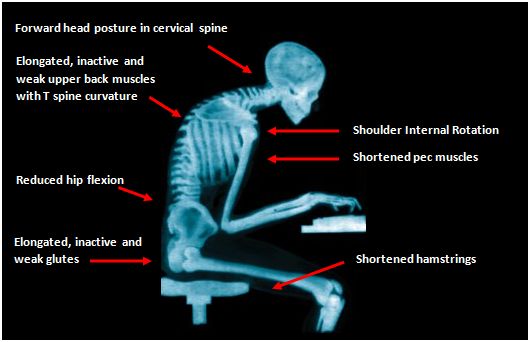Did you know that sustained postures and repetitive tasks can be just as debilitating, over time, as more demanding physical labour? This is due to a phenomenon known as hysteresis, or ‘creep’, where sustained or repetitive end-range loading of tissues and ligaments causes temporary tissue deformation. Over time, this can accumulate into micro-trauma of the ligaments and tissues surrounding a joint, eventually leading to symptoms of pain, stiffness, or reduced range of motion. These effects are cumulative, fortunately, however, there is much to be done to correct or prevent tissue damage when your job requires you to be at a desk for much of the day.
Ergonomics – the importance of your workstation
Ideally, we would all have standing workstations, as sitting puts more stress on the spine than standing! Slouching while seated exacerbates this even further. More and more, I am hearing of individuals who are given the option of a standing desk at work, and much to their surprise, leaving them feeling more energetic throughout the workday. If you are looking to replace your desk, consider opting for a standing solution. A variable height desk, allowing you to switch easily between sitting and standing, would be ideal. A list of different options available on the market can be found here.
If replacing your desk is not an option, stands like VARIDESK can be placed atop your current workstation. Feeling like MacGyver? Click here for an inexpensive Ikea solution and build your own standing desk. Here is another solution from Ikea.
Try a google search of your own, it looks like many folks have been creative, and shared their strategy for creating a standing workstation on the cheap! Having a fatigue mat to stand on, especially if your desk is on a hard surface such as concrete or wood flooring, is a good idea. Find a review on several options available here, and note the same MacGyver style desk in play! Those jumbo foam playmats that come in fun colours should also work well for those on a budget.
Things to consider: the height of your monitor is important – you want to see the top third of your screen when gazing straight ahead. Also, when using your keyboard, you want your wrists in a neutral position.
When you do sit: Have your chair adjusted so that your hips and knees are both at 90 degrees, with your feet touching the floor. Maintain a neutral spine, and shoulders rounded back and down. Also, consider replacing your chair with an exercise ball; this engages the core (abdominal) muscles. Find a size ball that has your hips and knees at 90 degrees, with your feet touching the floor. More tips on choosing a chair or ball for your workstation from the Canadian Chiropractic Association.
Take frequent breaks
Hysteresis, or creep, starts to set in quickly! When sitting, modify your posture every 20-30 mins. This can be from sitting to standing or shifting from neutral to leaning forward or backward (from the hips, maintaining a neutral spine!) in your chair. Absolutely get up from standing every 60 mins and stretch! Programs like StretchClock can alert you when it’s time to get up and stretch, and even provide videos for you to follow.
Chiropractic
Your chiropractor is able to recognize and treat joint dysfunction and tissue damage, even before you’re aware of it yourself. Wellness care is a great way to avoid acute episodes of work-related pain and discomfort. As always, how often you come to the clinic for an adjustment is up to you, but by tracking your symptoms, we are able to work with you and determine how the demands of your job and lifestyle will dictate the frequency of chiropractic care to maintain your quality of life. Book an appointment with Dr. Natasha Hayden.
Have any experience with a standing desk?
I’d love to hear from you! Share your story.
Dr Natasha Hayden is a pediatric and prenatal chiropractor that is passionate about helping her community discover just how good their bodies are designed to feel, so they can do more of what they love.
Your health goals are within reach with the support of our team.



